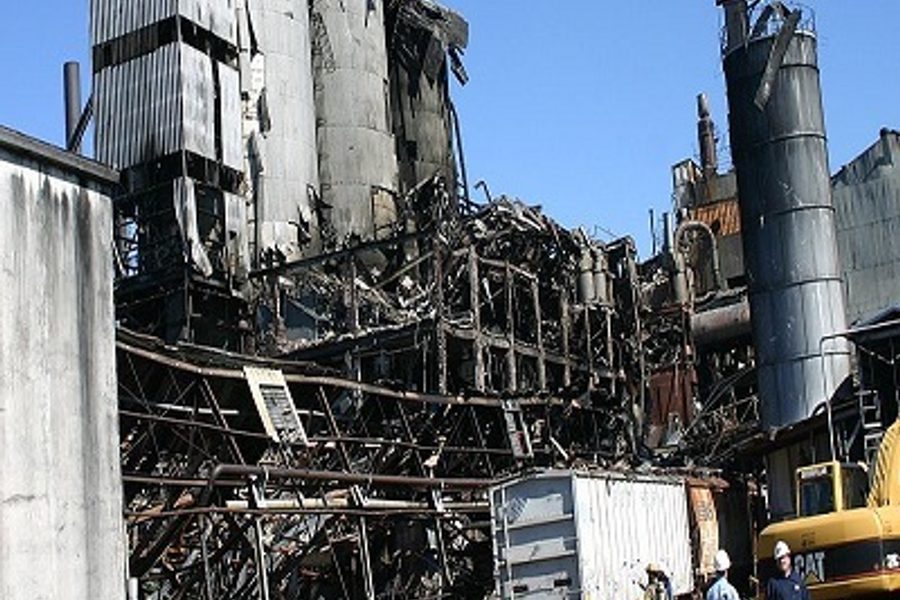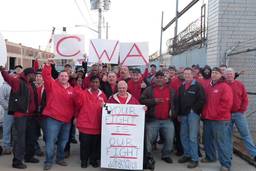“The system is a train wreck,” testified Mark Miser at a meeting yesterday of the federal Chemical Safety Board (CSB), which makes recommendations about how to avoid chemical-plant accidents. Miser’s brother-in-law, Shawn Boone, was killed in a preventable combustible-dust explosion at an aluminum plant in Indiana in 2003. “It seems that each organization designed to protect the workers is disconnected [from the others],” continued Miser. “This makes it very difficult for the families. We don’t know who to challenge.”
The anguish felt by families of explosion victims is one of the motivations behind the CSB’s decision, announced at yesterday’s hearing, to create a “Most Wanted Chemical Safety Improvement” program. The CSB hopes by designating a single chemical-safety issue as its “most wanted” improvement, it can push other federal agencies for swift action in cases where they have the power to act but are not doing so.
“A similar program has been operated by the National Transportation Safety Board for many years, reportedly with considerable success,” says Manuel Gomez, director of recommendations for the CSB.
As its first “most wanted” chemical safety improvement, the Chemical Safety Board is asking Occupational Safety and Health Administration (OSHA) to fast-track regulations on combustible dust in the workplace. Large build-ups of dust can often lead to fatal explosions of the kind that killed Shawn Boone in 2003, 29 miners in West Virginia’s Upper Big Branch Mine in 2009, and 13 workers in Port Wentworth, Ga.‘s Imperial Sugar plant in 2008.
Yesterday, the CSB officially designated OSHA’s slow progress on a combustible dust rule as “open-unacceptable.” Since 2006, the CSB has been calling on OSHA to issue a standard regarding combustible dust, but none has been forthcoming. In a study released that year, the CSB “identified 281 serious combustible dust incidents between 1980 and late 2005, with 119 fatalities, and more than 700 injuries, many of them quite serious in 44 states.”
After Obama tookoffice in 2009, OSHA began gathering information to create a rule on combustible dust. However in 2010, OSHA downgraded it to a “long-term action.” Earlier this year, Keith Wrightson, worker safety and health advocate for the watchdog group Public Citizen, told In These Times, “Based on previous experience with OSHA, it is likely that it will take eight to 12 years to issue a final rule for combustible dust.”
In testimony before the Chemical Safety Board earlier in the day, OSHA’s director of the directorate of enforcement programs, Thomas Galassi, testified that OSHA is hindered by its small $565 million dollar budget, which leaves few resources for rule-making.
Galassi testified, “Because of the enormous job OSHA has, and the limited resources available to perform those tasks, we must carefully choose which of these tools we use in any given situation and what the most effective and efficient action would be to address the most important hazards. Before deciding to address a hazard by promulgating a new standard, OSHA considers a number of factors, including the estimated time it takes to issue a final OSHA standard; the existing applicable OSHA standards; the usefulness of OSHA’s general duty clause for addressing particular hazards, including the existence of industry standards and codes that show industry knowledge of hazards; the effectiveness of training, education, consultation and outreach efforts; as well as vigorous use of the bully pulpit and OSHA’s available resources.”
Galassi adds that in the absence of a rule, OSHA has taken preliminary steps to address the problem of combustible-dust explosions. These include rigorous inspections of facilities prone to such explosions, in which inspectors look for other safety problems covered by existing OSHA rules in the hopes that this reduces the risk posed by combustible dust. OSHA has attempted to be creative in cracking down on combustible dust build-ups by using rules around housekeeping, such as sweeping and dusting, as well as the legally cumbersome “general duties” clause that requires employers to eliminate workplace hazards. And in 2007, OSHA added sites at risk of combustible dust explosions to a list of worksites that it inspect more frequently under the National Emphasis Program (NEP). According to Galassi, since the start of the NEP in 2007, OSHA has conducted over 3,700 targeted inspections of facilities prone to combustible dust problems and identified more than 14,000 total violations.
However, in an interview with In These Times following Galassi’s testimony, CSB Managing Director Daniel Horowitz stated that there’s a way OSHA could adopt the combustible-dust rule quickly: by adopting the codes on combustible dust set by the industry-run National Fire Protection Association. The recommendations of the National Fire Protection Association already form a part of many state and local fire codes across the country and, Horowitz says, “They’re very good.”
“Every single dust explosion the CSB has investigated could have been prevented by adhering to the NFPA codes,” said Horowitz. “So industry should be following them already because they’re referenced in the fire codes. [But] what we find is those codes are not regularly enforced in industrial facilities. Fire inspectors are focused on high-occupancy buildings like nursing homes, movie theaters, schools, [not] industrial sites. In the absence of that, we need a national standard in place.”
For families like Messer who have lost loved ones to combustible dust explosion, the wait has been too long.
“I feel the whole system to protect American workers is marginal at best,” said Miser in his testimony. “The civic protection agencies [such as OSHA] work together for the common interest of employees and their employers. They let politics get in the way of progress or safety.”









